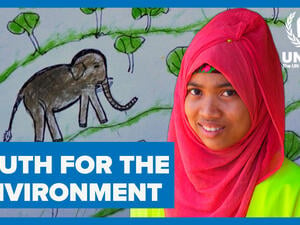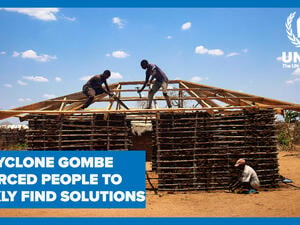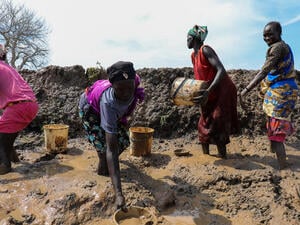Forging new leaders for a Colombian region torn by war

Forging new leaders for a Colombian region torn by war
Yurany Bañol vividly remembers the gun battles that ravaged her family’s home in Chocó, Colombia.
“We were in the middle, with the army over there and the people who’d taken the land over here,” Bañol says, recounting shoot-outs between military forces and opportunists who took control of farms left behind by people fleeing the violence. “Who knows how many dead people are buried along that road.”
Twenty-four-year-old Bañol’s story is nothing special in this region, splayed around the wide and lazy Atrato River. Residents have suffered for generations as paramilitaries, left-wing guerrillas and government forces battled for control. Targeted killings of those who spoke out against armed groups were common, as were mass displacements, forced recruitments and sexual abuse, traumatizing each generation in turn.
Like many other young people in the region, near Colombia’s isolated and hard-to-reach northwestern border with Panama, Bañol wanted something different for the future.
“Once you’ve lived that experience you don’t want anyone else to have to go through it,” says Bañol. Her family is still fighting in court to get their land rights reinstated, allowing them to go home.
“Before there was a much higher number of young people joining armed groups, and that has gone down a lot."
She and 139 other young area residents have found support for that desire for change through a first-of-its-kind programme backed by UNHCR, the UN Refugee Agency – the Inter-Ethnic Youth Leadership School.
The four-year-old school, which takes Afro-Colombian, mestizo and indigenous students between the ages of 14 and 29, periodically brings together young people and some 60 community leaders from the region for classes and discussions on how they can better shape their future.
Many students, even those who live in local hub Riosucio, have had limited opportunities to go beyond secondary school. Most work with their families in subsistence farming or fishing, but the programme teaches them advanced policy-making skills, along with public speaking and leadership tools. This year a group of 20 students will present policy proposals to local municipal councils on everything from healthcare and education to sports programmes and security issues.
“Before there was a much higher number of young people joining armed groups, and that has gone down a lot because now they understand that there is a different way to confront their needs, problems and the lack of opportunities,” says Yaneth Velasco, UNHCR’s community-based protection assistant for the region, who runs the school’s meetings.

Yurany Bañol, 24, attends the Inter-Ethnic Youth Leadership School in Colombia's war-torn Chocó region. Her family was displaced repeatedly when she was growing up.
The project is particularly relevant in Chocó, a remote province that has been hard hit by more than five decades of civil war. The conflict has uprooted some 7.3 million people within Colombia’s borders, and driven more than 340,000 refugees to seek safety abroad.
It may seem optimistic to believe that a leadership school can help young people solve the myriad problems in Chocó. But Velasco says “the last four years have shown it’s possible, and that we are being ambitious but should keep betting on this process.”
The students will need their newfound self-confidence and legal knowledge to navigate the region’s uncertain future. Following a peace deal with the government last year, the Revolutionary Armed Forces of Colombia (FARC) rebel group has pulled out of the area. Many Chocó residents supported peace talks, and voted by large margins to back the accord between the FARC and the government. Yet many fear the power vacuum left by the rebels will embolden ruthless crime gangs.
Absent large-scale government presence, illegal armed groups, many of whose members are former right-wing paramilitaries, have already begun to make inroads in previously FARC-controlled territory. These groups displaced over 2,200 people from their homes in Chocó in the first three months of this year, and there are reports of other violence.
“It’s a situation we foresaw,” says Velasco. “It’s very worrying and creates many risks for the population.” However, many communities are eager to host a school meeting, she says, because the presence of UNHCR gives them a measure of protection.

Yair Moña, 19, a member of the Wounaan indigenous community, says the Inter-Ethnic Youth Leadership School has brought together indigenous and Afro-Colombian communities.
Beyond its ambitious goal of forging future leaders, the school is already helping to bring the ethnically diverse community closer together, giving students the opportunity to meet and form friendships with other young people from their region they might not otherwise ever have met. Though indigenous tribes like the Wounaan and Embera live near Afro-Colombian populations and have often suffered violence at the hands of the same perpetrators, there was very little contact across ethnic lines.
“Before the inter-ethnic school the indigenous and the Afro-Colombians didn’t understand each other,” says Yair Moña, 19, a member of the Wounaan community. “But the school has made an improvement, now we’ve shared things.”
The oldest of 10 siblings, Moña’s young life was marked by displacement, something he would like to protect the Wounaan from in the future.
“I want to be the leader of my community and fight more to defend our land,” he says after the school’s most recent meeting in Riosucio, as his classmates flooded outside to mount motorbikes or board boats to take them back to their disparate communities.
UNHCR’s partner in the school, the Catholic Church’s Pastoral Social program, was key to making sure the efforts were separate from ethnic divisions.
“It is the duty of the church, which still has credibility with all the groups and is seen as impartial, to provide this service,” says Father Leonidas Moreno, a priest who has worked in the region for 37 years. “It’s not about evangelizing, what we want is a spirit of gathering together.”
“I want to be the leader of my community and fight more to defend our land.”
“It hasn’t been easy for the students to feel that now they can speak without fear,” Moreno says. “Before, that wasn’t possible – whoever spoke out, died.”
The school is also offering government officials a glimpse of successful youth engagement in the most complicated of circumstances.
“It’s an innovative idea, especially because it reaches these difficult-to-access areas,” says Diego Fernando Mata, an official from Colombia Joven, the government youth affairs department. Mata came to Riosucio to advise students on their policy proposals.
“Our hope is to have a public policy for youth in Riosucio at the end of the year, built with young people, the state and other actors, which will help generate opportunities in employment, education, culture, sport, health,” Mata added. He encouraged students to propose changes that will make a quantitative impact in their communities, like reducing the number of teen pregnancies and increasing the number of places at secondary schools.
Students have myriad ambitions – from community leader and social worker to lawyer and journalist. Bañol’s community already asked her to run for a municipal council position, but she declined, preferring to make change outside of notoriously corrupt political circles.
“Whatever I can do for my community I’ll do outside of politics,” says Bañol, who like many of the older students is already a parent, in her case to a five-year-old daughter. “I don’t want her to grow up in the same environment that I did.”








